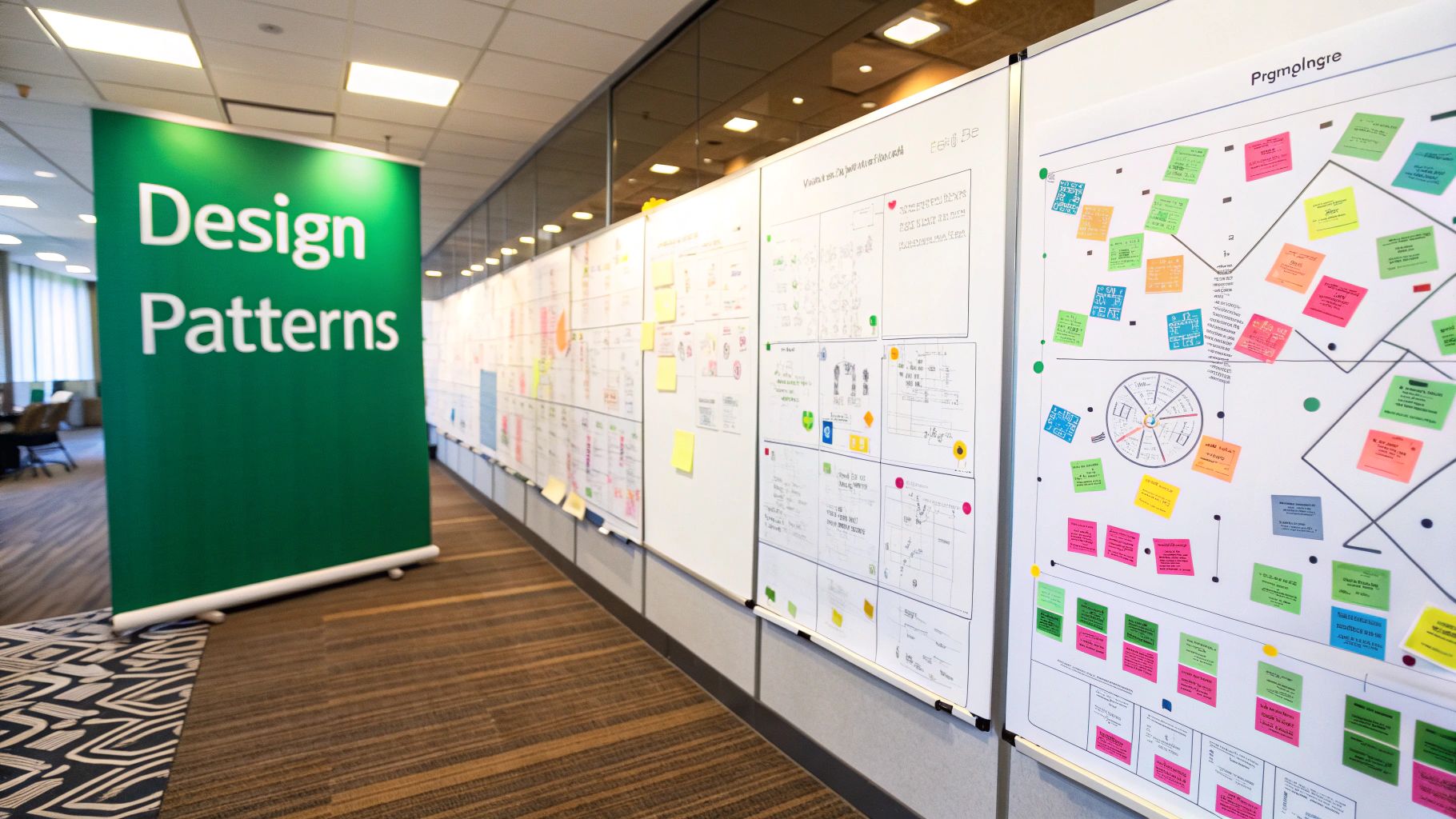Master proven software design principles that transform complex systems into maintainable, high-performing applications. Learn practical strategies and battle-tested approaches from industry pioneers.

Good software design principles are essential for building applications that work well and stand the test of time. These aren’t abstract theories - they’re practical guidelines refined through years of real-world development experience. Whether you’re coding solo or as part of a large team, understanding these core concepts will help you write better software.
The need for solid design principles became clear during the “software crisis” of the late 1960s. As projects routinely went over budget and failed to deliver, developers realized they needed better ways to organize and build software. This led to structured programming methods and the basic concepts we still use today. For instance, breaking code into clear, manageable modules directly addresses the complexity issues that caused many early projects to fail.
Several fundamental ideas guide good software design. Conceptual integrity means keeping the overall design consistent and easy to understand - it should feel like one cohesive system, even with multiple developers involved. Information hiding helps manage complexity by keeping the internal details of each module private. This way, developers can focus on their specific tasks without getting lost in the details of the entire system.
Cohesion and coupling are also crucial for writing modular code. Cohesion refers to how well the parts within a module work together - high cohesion means each module does one specific job well. Coupling describes how different modules connect and depend on each other. Less coupling between modules is better since changes in one area won’t break things elsewhere. It’s similar to building with blocks - each piece serves a clear purpose and can connect with others without losing its independence.
Object-oriented programming (OOP) emerged in the 1980s and added new tools to our design toolkit. Ideas like encapsulation, inheritance, and polymorphism made it easier to write modular, reusable code. Many current programming languages build on these concepts. However, it’s important to use OOP thoughtfully - overcomplicating things with unnecessary objects can make code harder to maintain.
Agile practices have also shaped how we design software today. The Agile approach emphasizes building software in small steps and working closely with users to meet their needs. This recognizes that requirements often change during development, so designs need to be flexible. To make this work, teams need to regularly review their code design and clean it up as needed. Regular design reviews and code improvements help maintain quality while staying responsive to changes.

Object-oriented programming (OOP) fundamentally changed how we write software by introducing concepts like encapsulation, inheritance, and polymorphism. These core ideas help developers create code that’s easier to maintain and reuse. Let’s explore how real development teams put these principles into practice, going beyond basic definitions to see their practical impact.
Think of encapsulation as creating a protective boundary around your code. It bundles related data and functions together while hiding the complex inner workings from outside interference. A good real-world comparison is your car - you don’t need to know how the engine works internally to drive it. You just use the steering wheel, gas pedal, and brakes to control it. This same principle applies to code - by limiting access to internal components, we prevent accidental changes and make the code more stable. When done right, changes to one part of the system won’t unexpectedly break other areas.
Inheritance lets you create new code by building on what already exists. You can make specialized versions of existing classes while keeping their core functionality. For example, if you have a basic Car class, you could create a RaceCar class that inherits all the standard car features but adds special racing capabilities. This approach saves time and keeps code organized. However, it’s important to use inheritance carefully - overusing it can make code too tightly connected and hard to change later.
Polymorphism gives code flexibility by letting you handle different types of objects in a consistent way. A great example is a payment system that processes various payment methods. Whether someone pays by credit card, PayPal, or bank transfer, the core payment processing code stays the same - it just adapts to handle each method’s specific requirements. This makes it simple to add new payment options without having to rewrite the main system logic.
While these OOP concepts are powerful, they need to be applied thoughtfully. Making code too complex with unnecessary abstractions can cause more problems than it solves. Many experienced developers emphasize keeping things simple - sometimes a straightforward approach works better than an elaborate class hierarchy. For more insights on this topic, check out our article on How to master software design principles. The key is finding the right balance between good design principles and practical solutions. This means carefully considering your project’s specific needs and avoiding complexity that doesn’t add real value. Sometimes the simplest solution is the best one, even if it means not using every OOP feature available.

Software development is all about solving problems effectively. Design patterns represent battle-tested solutions that help developers address common architectural challenges. These documented approaches have emerged from years of real-world experience, giving teams a shared language to discuss and implement proven solutions that make systems more maintainable.
Design patterns solve real problems that developers face daily. Take the Singleton pattern - it ensures only one instance of a class exists, which is perfect for managing resources like database connections or configuration settings. The Factory pattern offers another practical example, letting you create objects without tying your code to specific classes. But it’s worth noting that patterns aren’t magic bullets. Using them without proper consideration can actually make your code more complex than necessary, which brings us to choosing patterns wisely.
Picking the best pattern starts with a clear understanding of your specific problem. For example, the Observer pattern works great when you need multiple objects to react to changes in another object - think of updating multiple UI elements when data changes. The Strategy pattern lets you swap algorithms easily at runtime, like choosing different sorting methods based on your data. Success comes from knowing not just how patterns work, but when to use them based on your project’s needs.
Design patterns and SOLID principles work together to create better software. Consider how the Dependency Inversion Principle suggests working with abstractions instead of concrete implementations - patterns like Abstract Factory and Strategy help make this possible by reducing coupling between components. The Single Responsibility Principle finds expression in patterns like Facade, which keeps complex subsystems manageable by providing a clean interface. When patterns and principles align, they create stronger, more flexible systems.
While patterns are valuable tools, using them effectively requires good judgment. A common mistake is over-engineering - like using a Singleton when simple static methods would work fine. Some developers try to force patterns where they don’t belong, creating awkward solutions that hurt code quality. Each pattern comes with its own trade-offs - some might make your code more flexible but run slower. Good developers weigh these factors carefully, choosing patterns that solve real problems without creating new ones. This balanced approach leads to systems that are both well-designed and practical to maintain.

Building well-designed software requires careful thought and planning, even within fast-moving Agile development cycles. While Agile methods excel at delivering features quickly through short iterations, teams must actively work to maintain strong design principles throughout the development process.
Poor design choices can accumulate over time if teams focus only on short-term solutions. Quick fixes that bypass proper architecture often create technical problems that grow increasingly difficult to solve. Smart teams tackle this by making continuous design improvements part of their process. They regularly review code structure, identify areas needing cleanup, and set aside time to address technical debt. This ongoing maintenance keeps the codebase healthy and makes future development smoother. Teams that skip this step often find themselves slowed down by confusing, hard-to-modify code.
Teams can deliver value quickly while still building maintainable systems - it just takes thoughtful planning. Breaking large features into smaller pieces that align with good design practices helps achieve both goals. For example, teams might implement a complex feature gradually using established design patterns. This approach lets them ship useful functionality incrementally while establishing a solid foundation. The key is viewing quick wins and good design as complementary rather than competing priorities.
Different projects need different design approaches. A small proof-of-concept app requires less upfront design than a major enterprise system. Agile teams should assess each project’s specific needs when choosing design strategies. Projects with changing requirements may need more flexible designs that can evolve easily. Those with stable, well-defined needs can benefit from more detailed upfront planning. The most effective teams adjust their approach based on the project context rather than following a rigid formula.
Regular measurement helps teams stay on track with design quality. Basic metrics like code complexity scores and coupling between components can reveal potential issues early. Code reviews by experienced developers catch problems before they become embedded in the system. Static analysis tools can automatically flag common design mistakes. By monitoring these indicators consistently, teams can address design problems while they’re still small and manageable. This prevents the gradual decay that often happens when design quality goes unmeasured. The combination of metrics, reviews, and automated checks helps teams build robust systems that remain maintainable as they grow.
Building great software isn’t just about strong technical foundations - it’s about creating systems that users can easily understand and navigate. Even the most elegant architecture fails if users find it confusing or difficult to use. That’s why software design needs to prioritize user experience (UX) from the very beginning.
Understanding your users is the first step in creating truly user-friendly software. Teams need to collect feedback through multiple channels like surveys, interviews, and hands-on testing sessions. For example, one-on-one user interviews reveal specific pain points and needs, while running A/B tests helps measure how different design choices affect user behavior. By gathering real data instead of relying on assumptions, teams can make informed decisions. Regular feedback throughout development - from early prototypes to final testing - keeps the software aligned with what users actually want and need.
Every architectural choice impacts the user experience, from high-level information structure to individual component design. Take a complex enterprise system - breaking it into clear modules lets users access specific features directly without wading through unnecessary screens. This kind of thoughtful organization makes the software more approachable. The goal is to create interfaces that feel natural to use, with clear navigation that guides users smoothly through tasks. When done well, users can focus on their work rather than figuring out how to use the software.
Regular measurement helps teams understand if their design choices are working. Key metrics like task completion rates, error frequency, and satisfaction scores show where the software succeeds or needs improvement. Teams should define these metrics early and track them consistently. For instance, if users frequently abandon certain tasks, that highlights areas needing redesign. User surveys provide deeper context about overall experience. This data guides targeted improvements based on actual usage patterns rather than guesswork.
Great software balances user-friendliness with solid technical foundations like performance, scalability, and security. These goals can support each other rather than compete. Smart design patterns and best practices often improve both technical quality and usability. For example, clear error messages help users recover from problems while making the system more robust. By focusing on both technical excellence and user experience, teams create software that’s powerful yet accessible. This balanced approach leads to systems that users actually want to use - the true measure of success.
Good software design requires more than just following best practices during initial development. Teams need concrete ways to measure and improve design quality throughout a project’s lifecycle. By taking a data-driven approach to evaluating and enhancing design, teams can keep their codebase clean, maintainable, and resistant to technical debt.
Several specific metrics can help teams assess their code’s design health. Cyclomatic complexity shows how many different paths exist through a piece of code - higher numbers often point to code that’s harder to test and maintain. For example, a method with many nested if-statements would have high cyclomatic complexity and be a good candidate for refactoring.
Coupling measures how much different parts of the code depend on each other. When modules are too tightly coupled, changes in one area can unexpectedly break others. Teams can reduce coupling through techniques like dependency injection and clear interfaces between components. Code churn tracks how often specific parts of the codebase change - frequent changes may indicate design problems that need attention. By monitoring these metrics together, teams get a clear picture of their design’s strengths and weaknesses.
Regular code reviews play a key role in maintaining good design. Reviews catch potential issues early and ensure the team consistently applies design principles. Rather than just looking for bugs, reviewers should evaluate whether code follows principles like single responsibility and proper encapsulation. For instance, they might flag a class that’s trying to do too many things or suggest breaking up an overly complex method.
Code reviews also create valuable learning opportunities. Team members can share knowledge about design patterns and best practices, helping everyone write better code. This collaborative approach builds shared understanding and maintains high design standards across the project.
Refactoring means improving code structure without changing its behavior - like reorganizing a messy closet without throwing anything away. As software grows, regular refactoring helps maintain clean design. A class might gradually take on too many responsibilities as features are added. Through refactoring, developers can split that class into focused components that each do one thing well.
Teams should refactor when metrics highlight problems (like high complexity) or when code reviews reveal design issues. Small, incremental improvements prevent design decay and keep the codebase maintainable over time. Making refactoring a regular habit helps teams stay ahead of technical debt.
Technical debt builds up when teams choose quick fixes over better long-term solutions. While some technical debt is normal, too much makes future development slower and more error-prone. For example, repeatedly patching a poorly designed component instead of properly redesigning it leads to mounting maintenance costs.
Teams can manage technical debt by scheduling dedicated refactoring time and making small improvements during regular development. This balanced approach lets teams move quickly while keeping their codebase healthy. By tracking and systematically addressing technical debt, teams maintain the flexibility to adapt their software as needs change.
Streamline your documentation process and enhance your development workflow with DocuWriter.ai. Our AI-powered tools automate code and API documentation, saving you time and resources while ensuring accuracy and consistency. Explore additional features like UML diagram generation, code refactoring, and language conversion, all designed to improve the quality and efficiency of your software development process. Visit https://www.docuwriter.ai/ to learn more.